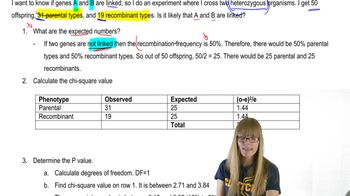In Bacillus subtilis, linkage analysis of two mutant genes affecting the synthesis of two amino acids, tryptophan (trp₂⁻) and tyrosine (trp₁⁻), was performed using transformation. Examine the following data and draw all possible conclusions regarding linkage. What is the purpose of Part B of the experiment? [Reference: E. Nester, M. Schafer, and J. Lederberg (1963).]
Table of contents
- 1. Introduction to Genetics51m
- 2. Mendel's Laws of Inheritance3h 37m
- 3. Extensions to Mendelian Inheritance2h 41m
- 4. Genetic Mapping and Linkage2h 28m
- 5. Genetics of Bacteria and Viruses1h 21m
- 6. Chromosomal Variation1h 48m
- 7. DNA and Chromosome Structure56m
- 8. DNA Replication1h 10m
- 9. Mitosis and Meiosis1h 34m
- 10. Transcription1h 0m
- 11. Translation58m
- 12. Gene Regulation in Prokaryotes1h 19m
- 13. Gene Regulation in Eukaryotes44m
- 14. Genetic Control of Development44m
- 15. Genomes and Genomics1h 50m
- 16. Transposable Elements47m
- 17. Mutation, Repair, and Recombination1h 6m
- 18. Molecular Genetic Tools19m
- 19. Cancer Genetics29m
- 20. Quantitative Genetics1h 26m
- 21. Population Genetics50m
- 22. Evolutionary Genetics29m
5. Genetics of Bacteria and Viruses
Bacterial Transformation
Problem 27
Textbook Question
For the experiment in Problem 26, another gene, g, was studied. It demonstrated positive cotransformation when tested with gene f. Predict the results of testing gene g with genes a, b, c, d, and e.
 Verified step by step guidance
Verified step by step guidance1
Understand the concept of cotransformation: Cotransformation occurs when two genes are close enough on the bacterial chromosome that they are transferred together during transformation. Positive cotransformation indicates that the genes are likely physically linked or close to each other.
Review the results of the experiment in Problem 26 to determine the cotransformation relationships between genes a, b, c, d, and e with gene f. This will help establish the relative positions of these genes on the chromosome.
Since gene g shows positive cotransformation with gene f, it suggests that gene g is located near gene f on the chromosome. Use this information to hypothesize the relative positions of gene g with respect to genes a, b, c, d, and e.
Predict the cotransformation results for gene g with each of the genes a, b, c, d, and e based on their proximity to gene f. If a gene is close to gene f, it is likely to show positive cotransformation with gene g as well. Conversely, if a gene is far from gene f, it is less likely to show cotransformation with gene g.
Summarize the predictions for each gene (a, b, c, d, and e) based on their relative distances to gene f and the observed cotransformation patterns. This will provide the expected results of testing gene g with these genes.
 Verified video answer for a similar problem:
Verified video answer for a similar problem:This video solution was recommended by our tutors as helpful for the problem above
Video duration:
2mPlay a video:
Was this helpful?
Key Concepts
Here are the essential concepts you must grasp in order to answer the question correctly.
Cotransformation
Cotransformation refers to the phenomenon where two or more genes are transferred together from one organism to another, often observed in bacterial transformation. This occurs when DNA from a donor bacterium is taken up by a recipient, leading to the expression of multiple traits. Understanding cotransformation is crucial for predicting genetic interactions and the likelihood of genes being inherited together.
Gene Interaction
Gene interaction describes how different genes influence each other's expression and the resulting phenotype. In the context of cotransformation, the interaction between genes g and f suggests that they may be located close to each other on the chromosome, affecting the likelihood of their co-inheritance. Analyzing gene interactions helps in predicting the outcomes of genetic experiments.
Recommended video:
Guided course

Interacting Genes Overview
Linkage Mapping
Linkage mapping is a genetic technique used to determine the relative positions of genes on a chromosome based on the frequency of recombination between them. Genes that are physically close tend to be inherited together, which is essential for predicting the results of testing gene g with other genes. Understanding linkage is vital for making accurate predictions about genetic outcomes in experiments.
Recommended video:
Guided course

Chi Square and Linkage


